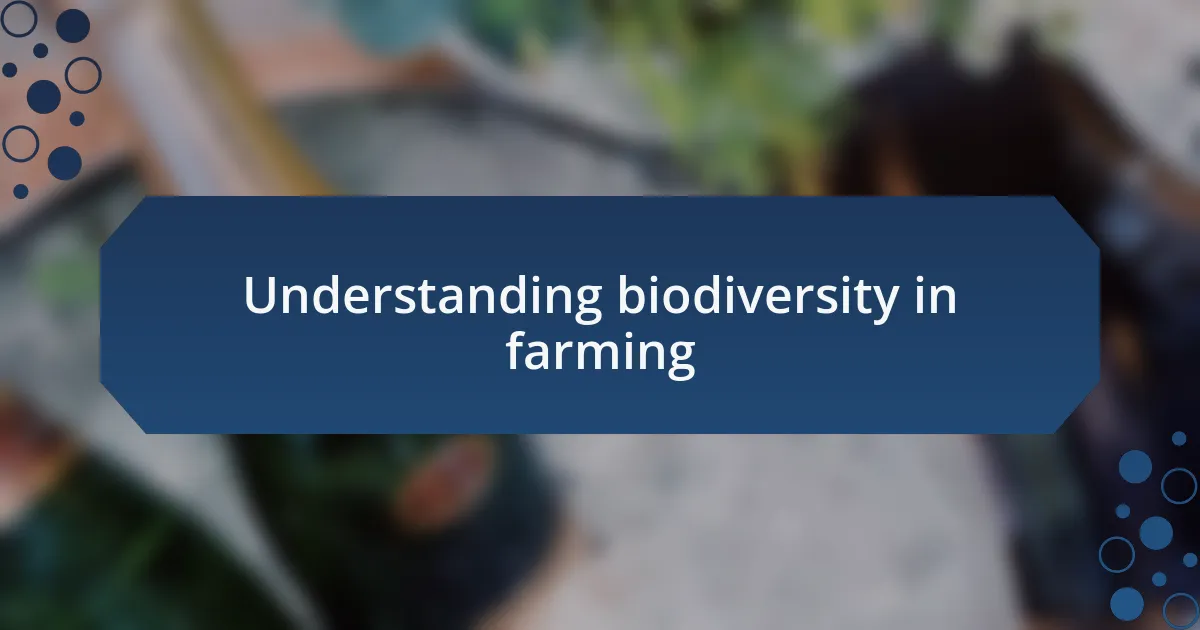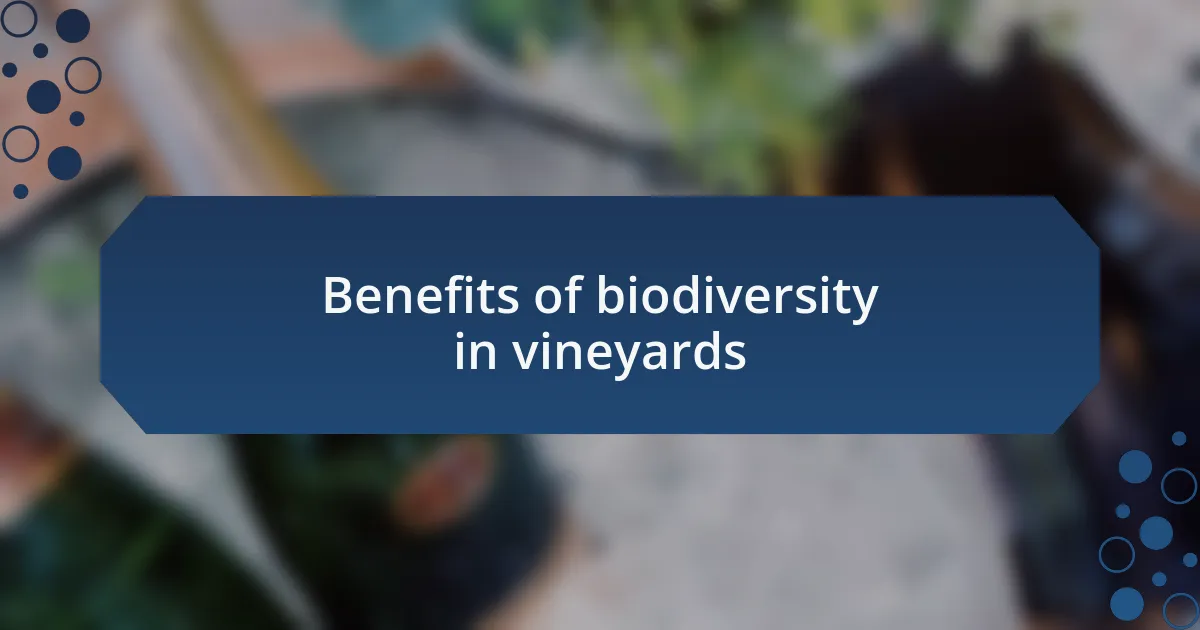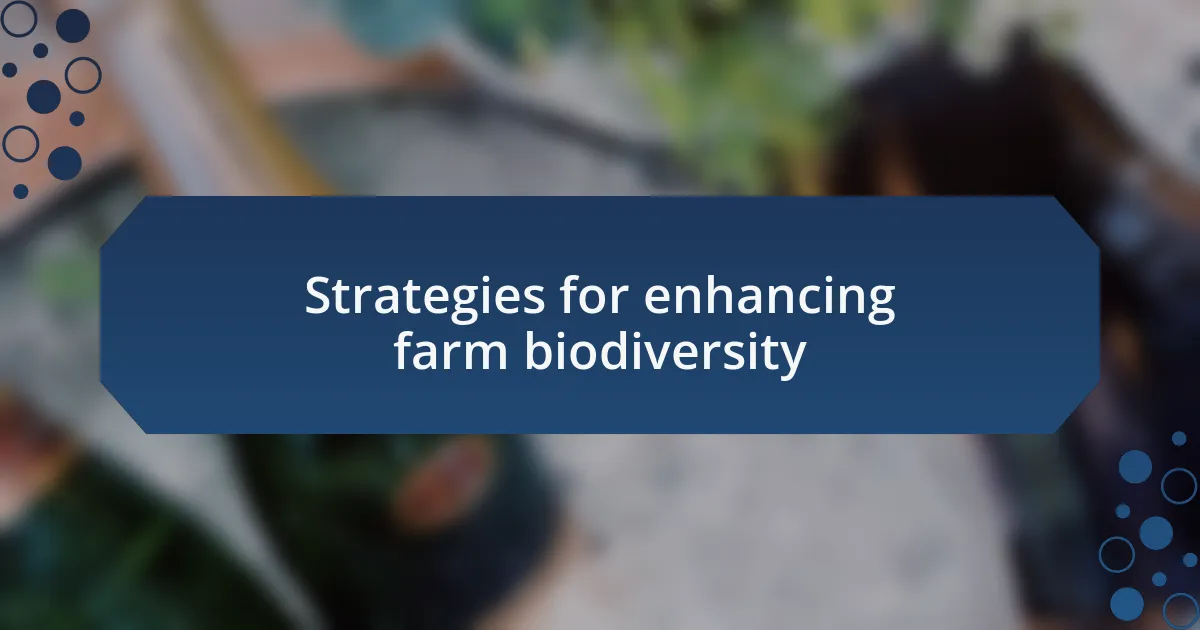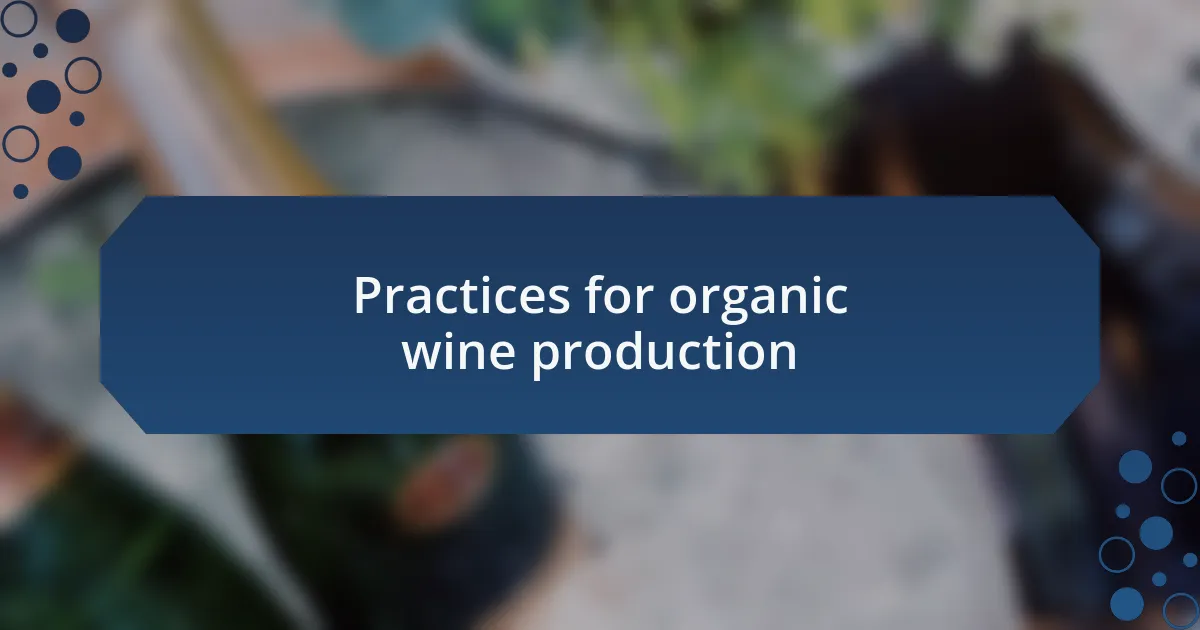Key takeaways:
- Biodiversity in farming enhances ecosystem interactions, improves soil quality, and contributes to better crop resilience and wine quality.
- Naturally diversified vineyards lead to effective pest control, healthier soil, and increased resilience against climate changes.
- Implementing strategies like pollinator gardens, integrating livestock, and following permaculture principles can significantly enhance farm biodiversity.
- Organic wine production benefits from careful crop selection and composting, which improve soil health and grape quality while fostering a stronger connection to the land.

Understanding biodiversity in farming
Biodiversity in farming goes beyond just the number of species present; it’s about the interactions between plants, animals, and microorganisms that create a vibrant ecosystem. I remember visiting a local vineyard where the owner emphasized how diverse plant life around the grapevines not only attracted beneficial insects but also helped to improve soil quality. Have you ever stopped to consider the microhabitats formed by different plants? They play a crucial role in maintaining the balance of pests and pollinators.
In my experience, when I diversify crops on my farm, I notice a marked improvement in resilience against diseases. For instance, when I introduced clover as a cover crop, it significantly enhanced soil fertility and reduced erosion. That symbiosis between species is fascinating—don’t you think? The more complexity I introduce, the more I see my farm flourishing.
What truly struck me was how biodiversity may also have a profound impact on wine quality. Grapes grown in a rich ecosystem tend to reflect the terroir more authentically, bringing out unique flavors that would otherwise go unnoticed. Isn’t it amazing how the intertwining life forms can influence the taste of a wine we enjoy? Ultimately, understanding and nurturing this intricate web of life is not just beneficial; it’s essential for sustainable farming.

Benefits of biodiversity in vineyards
One impressive benefit of biodiversity in vineyards is the natural pest control it provides. I recall a season when my vineyard was bustling with ladybugs and lacewings, which effortlessly kept the aphid population in check. It’s incredible how introducing a variety of flowering plants can create habitats for these beneficial insects, reducing the need for chemical pesticides. Doesn’t it make you think about how nature often has the best solutions?
Another advantage I’ve observed is the enhancement of soil health and structure. After planting diverse cover crops, I noticed a significant increase in earthworm activity, which aerated the soil and improved drainage. The feeling of pulling a perfectly ripe grape from the vine, knowing the soil is thriving, is nothing short of euphoric. Have you ever dug into soil that feels alive? It elevates not just the quality of the grapes but the entire experience of winemaking.
Moreover, biodiversity contributes to a vineyard’s resilience against climate fluctuations. I remember during a particularly dry summer, the diverse root systems of cover crops helped retain moisture in the soil. It’s amazing how these interconnected lives work together to support each other through challenges. Don’t you think if we embrace this interconnectedness, we can cultivate not just better grapes, but a more sustainable future?

Strategies for enhancing farm biodiversity
One effective strategy for enhancing farm biodiversity is planting a variety of native plants around the vineyard. I decided to create a pollinator garden filled with wildflowers, and it transformed my space. The sight of buzzing bees and fluttering butterflies not only enriches the ecosystem but also makes my heart swell with the joy of seeing nature flourish. Have you ever taken a moment to appreciate the beauty of such vibrant life?
Integrating livestock into the vineyard can also work wonders for biodiversity. I’ve experimented with using chickens to help manage weeds and pests, and the results have been eye-opening. Watching those cheeky birds scratch around the vines while adding natural fertilizer creates an atmosphere that feels more alive. Isn’t it fascinating how introducing another species can lead to a more harmonious farm environment?
Another approach I’ve found valuable is adopting permaculture principles to design the layout of my vineyard. By creating zones that mimic natural ecosystems, I noticed improved water retention and healthier plant interactions. The sense of balance this brings to the farm is incredibly rewarding. Can you imagine walking through a vineyard that thrives in sync with nature rather than battling against it? It’s a profound shift that has truly redefined my winemaking journey.

Practices for organic wine production
One key practice in organic wine production is the careful selection of cover crops. I’ve always been mindful of choosing plants that not only suppress weeds but also improve soil health. For instance, planting clover not only fixes nitrogen in the soil but also attracts beneficial insects. Have you ever imagined how a simple cover crop can serve multiple purposes on the farm?
Maintaining organic certifications requires diligent practices, but to me, the real reward comes from the connection to the land. Using organic compounds like sulfur for disease control may seem limiting at times, but I find it pushes me to be more innovative and attentive to the vineyard’s needs. I recall a year when I faced a challenging mildew outbreak, and relying solely on organic solutions not only taught me resilience but also deepened my appreciation for the natural balance.
Lastly, utilizing composting techniques has been a game-changer for my vineyard. I remember the first time I used homemade compost; it was like nurturing the soil with nature’s own magic. Watching the vines respond with vibrant growth reinforces my belief that sustainable practices elevate the quality of the wine we produce. Isn’t it intriguing how nourishing the earth can translate directly into the taste of the grapes?

Personal experiences in biodiversity management
Managing biodiversity on my farm has been a transformative experience. I recall one summer when I decided to introduce a variety of companion plants alongside my vines. The vibrant flowers not only created a stunning visual landscape but also invited a host of pollinators and pest-controlling insects. Had I known the impact this would have on my vineyard ecosystem, I might have embraced this approach sooner.
In another instance, I experimented with letting certain areas go wild, allowing native grasses and wildflowers to flourish. Initially, I feared the untamed look would deter customers, but to my surprise, many visitors have expressed admiration for the natural beauty. This shift in perception has even led to interesting conversations about the importance of supporting local biodiversity. Doesn’t it make you wonder how our perceptions of beauty can evolve?
One particularly poignant moment was when I saw a family of foxes making a home near the edge of my property. Instead of seeing them as a threat to my grapes, I recognized their role in maintaining the ecological balance. This experience reminded me that by embracing biodiversity, I’m not just nurturing my vines; I’m fostering a thriving environment that benefits all forms of life. It’s fascinating to think about the interconnectedness we often overlook, isn’t it?